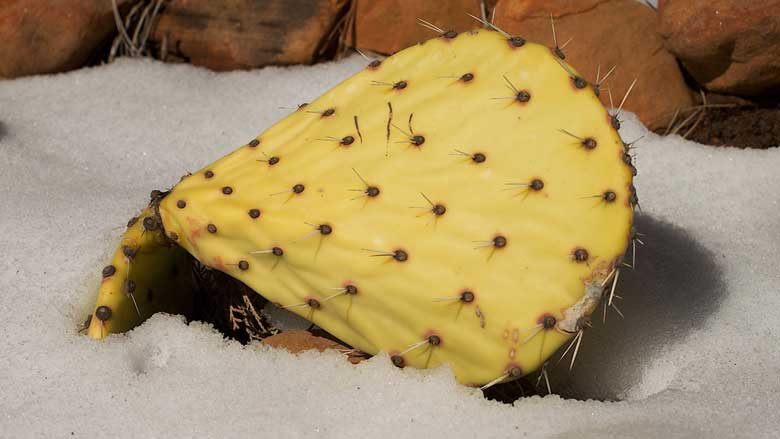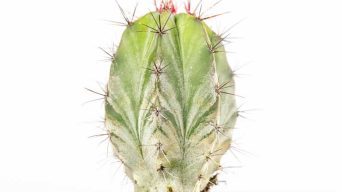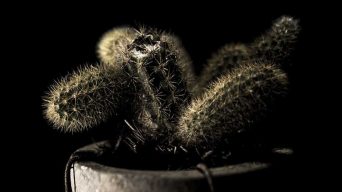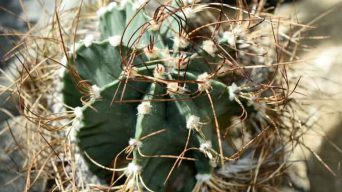Your cactus may turn yellow due to overwatering, insufficient light, excessive sun exposure, underwatering, poor soil quality, temperature changes, improper fertilization, pest issues, diseases, frost damage, or chemical exposure. Addressing the specific cause and adjusting care can help restore its health.
Cacti are among the world’s most popular plants, prized for their unique and often vibrant colors. Despite their widespread appeal, they can be challenging to maintain.
A common issue for cacti is yellowing, especially when grown in overly dry conditions or improper lighting.
But why is my cactus turning yellow?
Identifying the specific cause is crucial before attempting any treatment.
Here, we’ll explore why your cactus turns yellow and offer advice on how to remedy it.
11 Top Reasons Your Cactus Might Be Turning Yellow & How to Fix It
Cacti are susceptible to various issues that can cause them to become yellow.
Understanding these problems and how to address them can help you restore your cactus to its healthy state.
Here are the 11 top reasons your cactus might be turning yellow, along with solutions for each:
1. Overwatering: The Dangers and Remedies
A yellowing cactus is often the result of overwatering. Cacti need occasional watering but should be watered less than once a week in most cases.
If you overwater your plant, it will turn yellow (sometimes with some brown spots on its edges) and eventually die.
Ensure there are no standing water pools around the base of the plants or pots, which can lead to overwatering problems like rot or stem decay.
To prevent further yellowing due to overwatering, ensuring the soil is entirely dry before the next watering is recommended.
If this doesn’t solve the problem, make sure that there are no standing pools around its base and ensure it is getting enough sun and ventilation.
2. Insufficient Light: Finding the Right Balance
One common reason your cactus may turn yellow is that it needs more sun.
Cacti need a lot of sunlight to grow and thrive, so if you’ve kept it in the dark for too long, its color will change.
If the plant is outside, ensure no obstacles are blocking sunlight from reaching it.
In addition, check to see if your plants have been recently repotted and need more bright light before they begin sprouting new green growth.
The color of a succulent plant will also depend on its location in an interior setting because some types of artificial lighting can cause it to change its colors over time.
Place an indoor cactus where there’s plenty of natural light.
3. Excessive Sun Exposure: Protective Measures
Cacti are desert plants that need a lot of light to grow.
However, if you plant your cactus in an area exposed to intense sunlight, it can get fried and become yellow.
It is common for a cactus to sunburn and turn yellow if the plant is left in a sunny spot for too long.
The best way to prevent this is by repositioning your plant so it isn’t in direct sun all day.
You can also place your cactus plant in a spot with morning sun and afternoon shade or create a screen to block the sun.
Yellowing can also happen if you move your plant from shady to sunny areas.
If the plant is not used to getting so much sun, exposure will damage it and become yellow.
But this won’t last forever! If you gradually expose your cactus to more sunlight over time, its natural defenses will increase, too, preventing further damage or yellow discoloration.
4. Underwatering in Heat or Drought: Striking the Right Water Balance
A yellowish cactus often indicates insufficient water. This issue can arise from excessive sun exposure, prolonged drought, or neglecting to water the plant for an extended period.
To remedy this, increase the frequency and thoroughness of watering until the soil becomes moist. Mistreating the plant can prevent yellowing in arid conditions without rain or atmospheric moisture.
In hot or drought-prone areas, if your cactus has been yellow for weeks, consider these steps:
- Ensure it’s not in an overly bright spot, which could cause sunburn.
- If excessive light isn’t the issue, water generously, allowing the soil to dry thoroughly between waterings.
- Relocate the plant to a partially shaded area or near an open window to benefit from ambient humidity.
5. Soil Quality: Enhancing Nutrient Content
If a cactus is planted in soil of poor quality with insufficient nutrients, it will likely turn yellow.
Cacti require a high-quality, porous soil.
This soil should be dense enough to retain moisture but light enough to prevent the plant from becoming top-heavy or tipping over when watered.
Specially formulated potting mixes for cacti, often referred to as succulent or cactus soil, are highly recommended.
These mixes are enriched with vital nutrients such as iron and calcium, crucial for the healthy growth of the plant.
6. Temperature Variability: Maintaining Consistency
Frequent temperature changes often cause a cactus to become yellow. This color change may occur if the cactus is relocated to a new spot or comes into contact with heat from appliances such as oven vents or heaters.
If your cactus has remained in the same spot but the temperature has significantly changed, this could be the cause of the yellowing.
Gradually transition your cactus to its new environment over several days to prevent this. This gradual move helps the plant adapt to temperature changes without stress, reducing the likelihood of it turning yellow.
Patience is key. It is important to wait for the plant to regain its normal color before watering or fertilizing. Watering too soon after a temperature change, especially at high temperatures, can lead to root rot.
To prevent rotting roots, keep the soil consistently moist but not waterlogged. When moving a cactus between different environments, it is crucial to maintain its health by gradual acclimation to temperature changes.
7. Fertilization: Achieving the Right Mix
A cactus may become yellow due to over- or under-fertilization. Insufficient water leads to stress and nutrient deficiency, causing yellowing.
Applying too much fertilizer at once can cause the outer surface to brown and peel away as it decomposes.
Over-fertilization also leads to salt accumulation on the soil’s surface, preventing moisture absorption by the roots.
Correcting this issue involves regular watering without adding fertilizer for at least two weeks. Gradually reintroduce fertilizer until the plant improves and new growth appears.
8. Pest Problems: Identification and Control
A common cause of cactus discoloration is pest infestation, often from bugs like mealybugs or spider mites.
These pests deplete nutrients, turning the plant yellow.
Regular inspection of pests is crucial, as infestations can escalate rapidly.
Removing any dead organic matter near your plants is vital to prevent attracting more pests.
If you detect an infestation, I recommend using neem oil as a treatment. Apply it like an insect repellent, thoroughly spraying and rubbing it into the plant to ensure no residue remains.
Despite its unpleasant odor, neem oil is highly effective.
9. Disease: Identification and Treatment
Yellowing in cacti can indicate various diseases, including Cephaleuros wilt caused by Verticillium dahliae (Vd). This fungal infection blocks the plant’s water-conducting tissues, hindering water transport.
This might also result from other issues like chlorosis, an iron deficiency common in cacti and succulents due to their minimal nutrient absorption.
Affected plants often display a lighter green hue with light brown speckles. This condition can arise at any stage of the cactus’s life, typically triggered by either overwatering or underwatering.
If not addressed promptly, the cactus will eventually perish.
To combat this, repot the cactus in fresh soil for new nutrients and improved drainage. Trim any dead roots using scissors and ensure the plant receives ample direct sunlight.
10. Frost Damage: Prevention and Care
Frost damage, commonly signified by a cactus changing to a yellow color, can result in lasting damage to the plant’s cells and tissues, resulting in permanent scars on the cactus.
This damage typically occurs when temperatures fall below freezing overnight or through light freezes over several days.
Consider relocating your plants to an area with more sunlight or increased humidity to combat this.
If frost has already affected your plants, aiding its recovery is possible by keeping them in a place with temperatures around 50 degrees Fahrenheit.
As the plant warms and new growth emerges, gradually reintroduce it to its usual environment, ensuring all frost damage signs have vanished before doing so.
11. Chemical Exposure: Risks and Precautions
Certain chemicals, including chlorine and fluorine, frequently present in water and fertilizers, may lead to plants developing a yellow hue.
If you notice this discoloration in your cactus, it could result from chemical exposure, possibly from a nearby spill or overuse of these substances.
To protect your plants, consider relocating them to an area safe from potential contamination sources, like lawn sprinklers.
This precaution will help ensure their health and vitality away from harmful chemicals.
Strategies to Prevent Yellowing in Cacti
Ensuring the vibrant health of your cactus requires proactive measures to prevent the occurrence of yellowing.
Here are key strategies to maintain the lush green hue of your beloved succulent:
1. Achieving Optimal Sunlight
Cacti thrive in bright light, but excessive sunlight can lead to sunburn, resulting in yellowing.
To ensure the health of your cactus, it’s crucial to discern its specific sunlight requirements and regulate exposure accordingly.
Consider factors like sunlight intensity and duration, and if necessary, provide shade during peak sun hours to protect your cactus from potential harm.
2. Selecting the Best Soil for Drainage
The key to cactus health is choosing well-draining soil to prevent waterlogging, a common precursor to yellowing.
Incorporate perlite or sand into your potting mix to enhance drainage and safeguard your cactus from stagnant water. This measure is vital in preventing rotting roots, a prevalent issue associated with waterlogged conditions.
3. Watering Techniques for Cactus Health
Mastering the art of watering is pivotal in preserving your cactus’s vitality.
Overwatering is a primary culprit behind yellowing, leading to root rot and other moisture-related complications.
Establish a meticulous watering routine, allowing the soil to dry thoroughly between sessions.
Adjust the frequency based on environmental conditions, recognizing that your plant’s water needs may fluctuate with temperature and humidity.
4. Choosing the Right Pot Size
Choose an appropriately sized pot to give your cactus the spatial comfort it deserves.
Transplanting into a larger container as the cactus grows accommodates expanding roots and averts overcrowding. This proactive approach fosters healthier growth patterns, reducing the risk of yellowing induced by restrictive pot sizes.
5. Effective Fertilization Practices
Nurture your cactus with a balanced fertilizer during active growth phases, adhering to recommended dosages to prevent over-fertilization, a potential source of nutrient imbalances leading to yellowing.
Select a fertilizer specifically formulated for cacti to address their unique nutritional needs. This strategic feeding regimen fortifies your cactus against deficiencies compromising its vibrant green appearance.
6. Comprehensive Pest Management
Vigilance is key in the battle against pests undermining your cactus’s well-being.
Regularly inspect the plant for signs of infestation, such as webbing, discoloration, or visible insects. Promote targeted measures to curb pest spread, such as insecticidal soaps or neem oil.
Timely intervention shields your plant from adverse effects, including yellow spots or blemishes caused by pest-related stress.
7. Temperature Management for Cacti
Acknowledge the impact of temperature on your cactus’s health, especially during colder periods.
Shield your plant from extreme cold, as frost exposure can trigger stress responses, including yellowing.
Implement protective measures like relocating the plants indoors or providing insulation to mitigate temperature-related stressors and sustain its vibrant green vitality.
8. Regular Pruning and Maintenance
Ensure your cactus remains healthy and visually appealing through consistent pruning and maintenance.
Prompt removal of yellow or diseased parts is crucial for aesthetics and preventing the spread of conditions that cause further yellowing.
Regular pruning promotes fresh, healthy growth, resulting in a stronger and more resilient cactus. This resilience helps guard against discoloration and other stress-related symptoms.
By integrating these preventive steps into your cactus care regimen, you can markedly decrease the likelihood of yellowing, maintaining your plant as a lively and flourishing element of your botanical collection.
Can a Yellow Cactus Turn Green Again?
This depends on why the cactus has turned yellow in the first place.
As we’ve seen, some reasons are due to the damage that can’t be undone, such as exposure to chemicals or being eaten by pests.
Other times, it may only be a matter of moving your plant to a more ideal environment for its growth, which could be good for its recovery.
In most cases, however, a yellow cactus will not turn green again on its own accord.
Trying one of the treatments we’ve listed above may help get your plants back to their original color, but it’s also possible that the plant will remain yellow or even die if the cause of the problem is not remedied.
Final Thoughts on Cactus Care
The yellowing of your cactus can result from various factors, necessitating a thorough assessment of the plant and its surroundings.
An essential factor to consider in comprehending the yellowing issue is the potential influence of inadequate care.
Therefore, when faced with a cactus exhibiting a yellow hue, the initial proactive step is to examine your care routine for deficiencies.
By identifying and rectifying these lapses in your home and garden, you can significantly restore your cactus to a vibrant and healthy state, underscoring the importance of diligent gardening practices in caring for these resilient plants.







